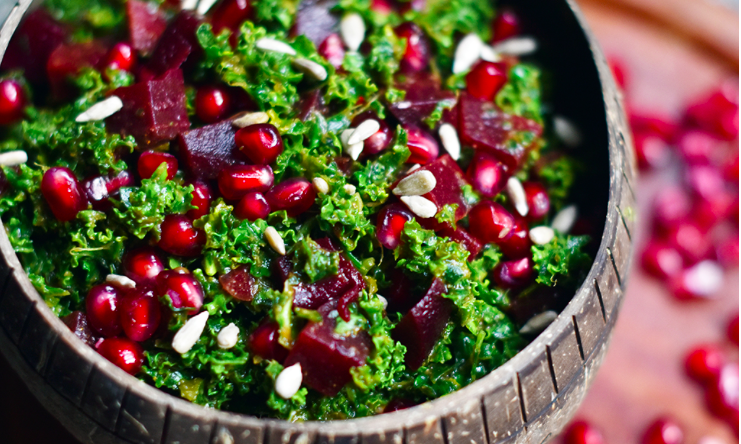Raw vegan, sweet and spicy kale salad with beetroot
raw-vegan
Ingredients (for servings, )
| For the salad | |
|---|---|
| 4 leaves | Kale, raw (spring cabbage, organic?) (3.7 oz) |
| 8 ½ oz | Beetroot, raw (organic?) |
| 1 | Pomegranate (grenadine, raw, organic?) (9.9 oz) |
| 3 ½ oz | Sunflower seeds, raw (organic?) |
| For the sauce | |
| 1 | Oranges, raw (organic?) (4.6 oz) |
| 200 ml | Drinking water, raw (organic?) (7.0 oz) |
| 3 tbsp | Mustard seeds, yellow-white (raw, organic?) (1.1 oz) |
| 1 tbsp | Apple cider vinegar (raw?, organic?) (0.52 oz) |
| 2 tsp | Turmeric (saffron root), ground, raw (organic?) (0.21 oz) |
| 1 dash | Table salt (table salt, raw?, organic?) (0.01 oz) |
| 4 | Dates, Medjool variety, pitted, raw? (organic?) (3.4 oz) |
Equipment
- blender or hand-held blender / immersion blender
- vegetable peeler
- citrus juicer (lemon squeezer)
Type of preparation
- chop or grind
- food preparation without heating
- blend
- squeeze
- peel
Preparation
For the salad
Wash the kale, remove the stalk and chop into small pieces. Peel the beetroot and cut into small cubes. Remove the pomegranate seeds from the pomegranate.The easiest way to deseed pomegranates is in a bowl filled with water, see "Tips".
Place the kale, pomegranate seeds, beetroot and sunflower seeds in a large bowl and mix together.
For the sauce
Squeeze the orange(s). Put the juice in a blender with the other ingredients for the dressing and process into a sauce.Arranging and Serving
Pour the sauce over the salad and garnish with nuts or seeds as desired.
|
Nutritional Information per person
Convert per 100g
|
2000 kcal | |
|---|---|---|
| Energy | 736 kcal | 36.8% |
| Fat/Lipids | 33 g | 46.6% |
| Saturated Fats | 2.8 g | 13.8% |
| Carbohydrates (inc.dietary fiber) | 104 g | 38.5% |
| Sugars | 70 g | 78.3% |
| Fiber | 22 g | 87.1% |
| Protein/Albumin | 22 g | 45.0% |
| Cooking Salt (Na:209.9 mg) | 533 mg | 22.2% |
| Essential micronutrients with the highest proportions | per person | 2000 kcal | |
|---|---|---|---|
| Vit | Vitamin K | 392 µg | 522.0% |
| Min | Copper, Cu | 2.3 mg | 231.0% |
| Vit | Vitamin B9, B11 (Folate, as the active form of folic acid) | 404 µg | 202.0% |
| Vit | Vitamin E, as a-TEs | 20 mg | 163.0% |
| Vit | Vitamin C (ascorbic acid) | 118 mg | 148.0% |
| Min | Manganese, Mn | 2.9 mg | 147.0% |
| Fat | Linoleic acid; LA; 18:2 omega-6 | 12 g | 122.0% |
| Prot | Tryptophan (Trp, W) | 0.29 g | 116.0% |
| Vit | Vitamin B1 (Thiamine) | 1.1 mg | 99.0% |
| Elem | Potassium, K | 1'939 mg | 97.0% |
Detailed Nutritional Information per Person for this Recipe
The majority of the nutritional information comes from the USDA (US Department of Agriculture). This means that the information for natural products is often incomplete or only given within broader categories, whereas in most cases products made from these have more complete information displayed.
If we take flaxseed, for example, the important essential amino acid ALA (omega-3) is only included in an overarching category whereas for flaxseed oil ALA is listed specifically. In time, we will be able to change this, but it will require a lot of work. An “i” appears behind ingredients that have been adjusted and an explanation appears when you hover over this symbol.
For Erb Muesli, the original calculations resulted in 48 % of the daily requirement of ALA — but with the correction, we see that the muesli actually covers >100 % of the necessary recommendation for the omega-3 fatty acid ALA. Our goal is to eventually be able to compare the nutritional value of our recipes with those that are used in conventional western lifestyles.
| Essential fatty acids | per person | 2000 kcal |
|---|---|---|
| Linoleic acid; LA; 18:2 omega-6 | 12 g | 122.0% |
| Alpha-Linolenic acid; ALA; 18:3 omega-3 | 0.71 g | 36.0% |
| Essential amino acids | per person | 2000 kcal |
|---|---|---|
| Tryptophan (Trp, W) | 0.29 g | 116.0% |
| Threonine (Thr, T, irreversibly transaminated) | 0.72 g | 78.0% |
| Isoleucine (Ile, I) | 0.84 g | 68.0% |
| Valin (Val, V) | 1.0 g | 62.0% |
| Phenylalanine (Phe, F) | 0.86 g | 55.0% |
| Leucine (Leu, L) | 1.3 g | 52.0% |
| Lysine (Lys, K, irreversibly transaminated) | 0.84 g | 45.0% |
| Methionine (Met, M) | 0.37 g | 39.0% |
| Vitamins | per person | 2000 kcal |
|---|---|---|
| Vitamin K | 392 µg | 522.0% |
| Vitamin B9, B11 (Folate, as the active form of folic acid) | 404 µg | 202.0% |
| Vitamin E, as a-TEs | 20 mg | 163.0% |
| Vitamin C (ascorbic acid) | 118 mg | 148.0% |
| Vitamin B1 (Thiamine) | 1.1 mg | 99.0% |
| Vitamin B6 (pyridoxine) | 1.2 mg | 85.0% |
| Vitamin B7 (Biotin, ex vitamin H) | 31 µg | 62.0% |
| Vitamin B3 (Niacin) | 9.0 mg | 56.0% |
| Vitamin B2 (Riboflavin) | 0.49 mg | 35.0% |
| Vitamin A, as RAE | 275 µg | 34.0% |
| Vitamin B5 (Pantothenic acid) | 2.0 mg | 33.0% |
| Essential macroelements (macronutrients) | per person | 2000 kcal |
|---|---|---|
| Potassium, K | 1'939 mg | 97.0% |
| Phosphorus, P | 653 mg | 93.0% |
| Magnesium, Mg | 318 mg | 85.0% |
| Calcium, Ca | 295 mg | 37.0% |
| Sodium, Na | 210 mg | 26.0% |
| Essential trace elements (micronutrients) | per person | 2000 kcal |
|---|---|---|
| Copper, Cu | 2.3 mg | 231.0% |
| Manganese, Mn | 2.9 mg | 147.0% |
| Iron, Fe | 9.8 mg | 70.0% |
| Selenium, Se | 29 µg | 53.0% |
| Zinc, Zn | 4.8 mg | 48.0% |
| Iod, I (Jod, J) | 3.3 µg | 2.0% |
| Fluorine, F | 79 µg | 2.0% |
The raw vegan, sweet and spicy kale salad with beetroot and pomegranate seeds is served with orange and turmeric dressing. Depending on the portion size, it can also be used as a starter or side dish.
Nutrient profile: This recipe has an extremely high proportion of vitamin K, which plays an important role in blood clotting and bone metabolism. Furthermore, according to GDA guidelines, one portion of this recipe covers more than twice the average daily requirement of copper and folic acid and over 100% of that of vitamin E, vitamin C, tryptophan and manganese. The ratio of omega-6 to omega-3 fatty acids is 17:1, which is significantly higher than the recommended maximum ratio of 5:1, due to the sunflower seeds.
Health: For health reasons, we have created an alternative recipe with variations in the ingredients. Please read the link behind this motivation: Vegans often eat unhealthily. Avoidable nutritional errors.
Kale: This hearty winter vegetable has one of the highest vitamin C contents of all types of cabbage. Moreover, kale, especially when eaten raw, provides a wide variety of nutrients, including many vitamins, fiber and plant compounds.
Beetroot: The characteristic red color of beetroot is mainly due to the high concentration of the glycoside betanin from the group of betalains. Beetroot is a healthy vegetable due to its high folic acid content, among other things, and can be eaten cooked or raw.
Sunflower seeds: Sunflower seeds contain a lot of vitamin E and over 90% unsaturated fatty acids. However, only omega-6 fatty acids are very well represented among these.
Orange: The orange is a cross between a grapefruit ( Citrus maxima) and a mandarin ( Citrus reticulata). Oranges are a popular ingredient in many dishes, and not just because of their high vitamin C content. They can be used raw, cooked or just their juice in preparations.
Turmeric: Turmeric originally comes from South Asia and belongs to the ginger family (Zingiberaceae). Fresh turmeric has a peppery, slightly spicy taste. When dried, it tastes milder and slightly bitter.
Beetroot: People who are prone to the formation of kidney stones, such as Crohn's disease patients, should only consume beetroot in moderation due to its high oxalic acid content.
Storing turmeric: Turmeric is best stored in a dark place, otherwise you can expect a loss in color and taste.
Simply deseed pomegranates: The seeds of Pomegranates are very rich in nutrients. They are rich in vitamins K and C, phenols, folic acid and potassium, among other things. If you open the pomegranates and remove the seeds by hand in a bowl filled with water, the whitish septum will float on the surface of the water while the seeds sink to the bottom of the bowl. This makes it easy to separate the bitter skin from the juicy seeds. There are also YouTube videos that provide tips on handling pomegranates and that visualize the process described above.







